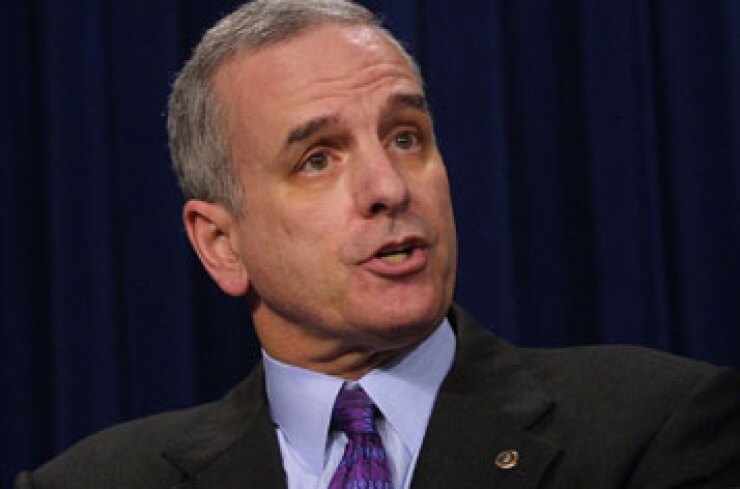
CHICAGO — Minnesota Gov. Mark Dayton unveiled an $842 million bond-financed
The package, supported by state general obligation bond issuance, appropriation-backed borrowing, and Minnesota Housing Finance Agency bonding, would leverage spending of $1.2 billion when user-financing, federal funds, and local matching and private funds are counted, according to the Dayton administration.
"I ask the Legislature to join me in working to pass a jobs bill this session to boost Minnesota's economy and address our state's most crucial infrastructure needs," Dayton said in the statement announcing the legislation.
Dayton estimated the package would create 23,900 jobs.
About 43% of the funding would go to projects located around the state and 38% to the Twin Cities area, with 19% earmarked for projects considered to have a statewide impact.
Some projects in line for aid include $48 million for the Lewis & Clark Water System, $10 million for port improvements, $12 million that would fund local economic development grants, and $64.6 million for highway rail grade separation projects.
The plan allocates $140 million for asset preservation and improvements at public higher education institutions and $18 million to replace two veterinary laboratories at the University of Minnesota.
The bill would provide $50 million for workforce housing projects, $50 million for subsidized rental housing improvements and $20 million to cover "unforeseen" expenses for the ongoing renovations to the state capitol.
The bill would allocate $61.4 million for improvements at Department of Corrections' facilities.
Dayton is bucking state tradition for his capital proposal, which could create obstacles for it.
Lawmakers traditionally tackle a large package known as the "bonding bill" in the year after approving a two-year operating budget.
This year the operating budget to cover the biennium beginning July 1 is before the Legislature.
The bonding bill last year was $857 million. The state limits the size based on self-imposed state rules limiting debt service to a percentage of state personal income.
Dayton is a member of the state's Democrat-Farmer-Labor Party and enjoys a Senate majority while the GOP controls the House.
New borrowing requires a three-fifths majority vote instead of the simple majority required by most legislation, so Dayton's plan may hit a legislative roadblock.
Dayton said the given its budget surplus, the state can afford the bigger package.
"I think this is a perfect opportunity. Interest rates are low, we have a budget surplus, and there are all these projects backed up," the governor said.
In addition to competing with the operating budget, the bonding bill package joins an agenda that includes competing transportation funding bills. Dayton and DFLers have proposed new and higher taxes and fees to support a 10-year, $11 billion program, but Republicans want to tap the state's surplus.
The state's latest revenue estimate in early March added another $800 million to a projected surplus, more than doubling the extra revenue expected in the current biennial.
Dayton earlier this year proposed a $42 billion, two-year operating budget that would use $1 billion of the surplus to increase education spending.
Ahead of Minnesota's last new money sale in the summer, Fitch Ratings affirmed the state's AA-plus rating, Moody's Investors Service affirmed its Aa1 rating, and Standard & Poor's affirmed its AA-plus rating.
All assign a stable outlook. The ratings affect $6 billion of GO debt.





